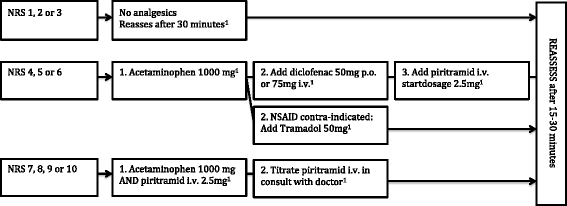Increased analgesia administration in emergency medicine after implementation of revised guidelines
- PMID: 26860533
- PMCID: PMC4749514
- DOI: 10.1186/s12245-016-0102-y
Increased analgesia administration in emergency medicine after implementation of revised guidelines
Abstract
Background: The most common complaint of patients attending the emergency department (ED) is pain, caused by different diseases. Yet the treatment of pain at the ED is suboptimal, and oligoanalgesia remains common. The objective of this study is to determine whether the administration of analgesia at the ED increases by implementation of revised guidelines in pain management.
Methods: We conducted a prospective pre-post intervention cohort study with implementation of a revised guideline for pain management at our ED, in which nurses are allowed to administer analgesia (including low-dosage piritramid (opioid) intravenous) without doctor intervention. Numeric Rating Scales (NRS) were measured, and administration of medication (main outcome) was documented. We included every adult patient presenting with pain (NRS 4-10) at the ED.
Results: A total of 2107 patients (1089 pre-implementation phase and 1018 post-implementation phase) were included in our study. During pre-implementation, 25.4 % of the patients with NRS between 4 and 10 received analgesia. After implementation, 32.0 % of these patients received analgesia (p < 0.001).
Conclusions: After implementation of the revised guidelines in pain management at the ED, the administration of pain medication increased significantly. Nevertheless, the percentage of patients in pain receiving analgesia remain low (32 % after implementation).
Keywords: Acute pain; Analgesics; Emergency department; Pain management.
Figures
References
-
- Carter D, Sendziuk P, Eliott JA, Braunack-Mayer A. Why is pain still under-treated in the emergency department? Two new hypotheses. Bioethics. 2015. PMID:26104124 [Epub ahead of print]. doi:10.1111/bioe.12170. - PubMed
LinkOut - more resources
Full Text Sources
Other Literature Sources



